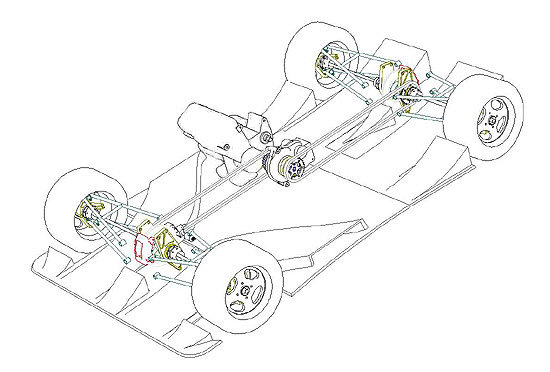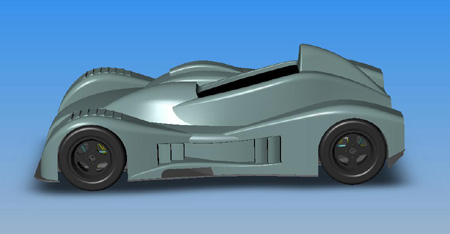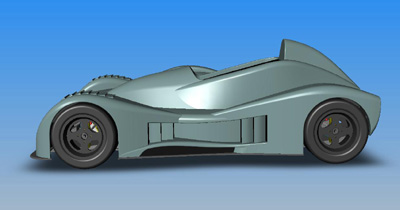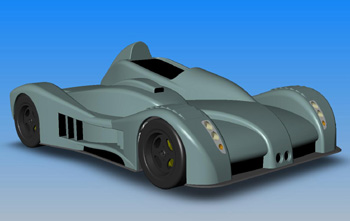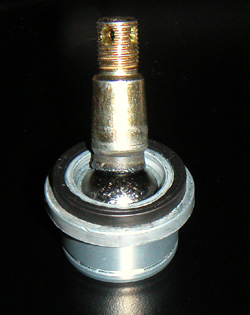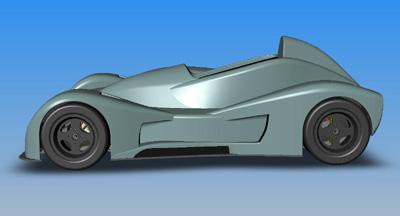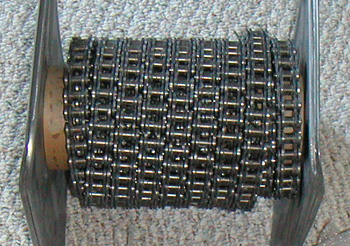|
04/26/03 Doing some preliminary work on aerodynamics. It looks like I'm able to get a lot of high-quality tunnel volume in a car that is only 112" long, with 80" wheelbase. All this is accomplished while maintaining a flat floor for over 45% of the wheelbase, as required by DSR rules. In fact a couple of the soultions I'm quite proud of, such as the front diffuser exhaust ducts...
But of course just as soon as I got all happy with my nifty diffuser exhausts, I went browsing the excellent MullsannesCorner site and found that the 2003 Lister Storm is already doing exactly that. Well, at least my thinking is on the cutting edge of LMP technology :) The overall design at the moment looks like this:
Now that the first pass at the underbody design is done, I need to spend some time on the internal airflow ducts. This includes front radiators, oil cooler, brakes and engine compartment venting. Proper design should take care of both inlet and exhaust routing for each, and account for overall effect on airflow around the car. Naturally I'm just eyeballing all this as I lack any kind of wind tunnel capability at the moment. Still, it should at least be a whole lot better than the Westie! I'm hoping to eliminate the need for a rear wing and just use the underbody downforce which is 'free' as far as drag goes. The primary front/rear balancing devices would be the use of a Gurney flap in the back and dive planes on the nose. That's waaaay down the road though. In the meantime, after a day of tweaking the details of rear aerodynamics, the design has evolved a bit (compare with above):
The process is that of iterative refinement now (or second-guessing in some cases). The priorities are clearing mechanical components, downforce, esthetics and manufacturability/cost - in that order. Looking back only three days, the design looked like this:
CAD allows very rapid prototyping where the only cost is the time to do it. Clearances can be checked, esthetics evaluated, functionality of features examined. The difference between the two pictures above for me was three days. Using old-fashioned methods it would likely be seveal months and many thousands of dollars. In fact, it often amazes me how much people accomplished in the 'old days' before modern tools were around. My hat is off to all of them. 05/02/03 A few more days of tweaking the body design. I've done a number of different variatons, some subtle some not very. I then printed out same views of each one and laid them out side by side for comparison. This is the one that I've settled on so far:
Of course it is still subject to change from component clearance, manufacturability and esthetic considerations. For example I've already had to enlarge the fenders because I looked up the actual dimensions of the three different tire types I plan to use and couple of them were wider and taller than I had accounted for (the 225/45-13 hoosier DOT tire is 20.7" in diameter and 9.0" wide, and 20x8-13 slick is 20.0" diameter and 9.2 wide). I'm sure there will be more such 'discoveries'. In the meantime, this is the latest and greatest. Have to spend some time on the frame now. 05/25/03 Worked on the design some more - mostly cleaned up the back end and the underbody. Also gave a lot of thought to various other design issues, will put into CAD over the next few days.
It's great to be able to go away for a while, then come back and take a fresh look at the various solutions. The design is looking more and more 'real', but of course a huge amount of work remains.... 06/12/03 Progress is slow but steady. Yet another delay on the diffs (I was supposed to have them all done in February). Good thing I have a lot of other work to do and I'm not really held up by this. Been struggling with suspension items a bit. My original plan was to use balljoints at the outer end of control arms and nylon-type bushings at the inboard end. Of course I still want some camber adjustability... So in my quest for knowledge I took the dust cover off the Honda ATV balljoint I was going to use.
Good thing I did. the stud seems to be welded to the ball (friction weld?) - not something I'd want to trust at 160 mph and 2g. A check of the Internet revealed a recall on ATV balljoints by the same manufacturer. Perhaps I'm not crazy. So I looked around for some options - and didn't find anything useful. Most compact balljoints out there are tension-type, and I need compression loading on mine (due to suspension layout which is driven by need for underbody tunnel clearance). So I eventually decided to go with 1/2" premium rod ends outboard. Those are rated for 15,500 lbs radial load and 1,600 lbs axial - so I can hang two of my cars from just one joint in its weakest direction. That'll do. The price is double that of the balljoints ($40 ea vs $20 ea), but what's my life worth? Even though the bolts attaching them will be in single-shear, a 1/2" mil-spec bolt is a hell of a lot stronger than a 1/2" friction weld of unknown material! Also talked on the phone with Composites Unlimited about my bodywork design (I had sent them CAD files a couple of weeks ago). They were not thrilled about all the detail like the louvers, intake scoop and stepped side ducts. Much labor, much cost. Fair enough - so I spent some time cleaning up the design (also figured out single intake design for turbo and NA configurations).
Next week I'll go and meet with them in person and discuss the particulars. It's a steep learning curve for me. I know what it takes to make a manufacturable printed circuit board, or even an injection-moulded plastic enclosure. This large-size composite stuff is all new territory. All the more fun then :) 06/17/03 Had a very good meeting with Composites Unlimited. I now have a much better understanding of the manufacturing process, the materials and the tradeoffs. Turns out that louvers are very doable, albeit labor-intensive. They do add a bit of cost but not too bad and I like them cosmetically. Now I can tweak the design some more with what I've learned. I really do need to quit messing with the bodywork for now and get on with the structure. But it is human nature that making modifications to something that is already there is more comfortable than creating the foundation of something new - and so even in this type of project I'm compelled to tweak what I've already designed instead of designing things that I haven't gotten to yet. Funny. Click on the picture above for a larger, 1024x768 version.
Also a few more drivetrain parts showed up, including 25 feet of chain (this is enough to do the two chains and one spare). Still no word on the diffs.
Next week is a meeting with a large local machine shop who have lots of capabilities and will hopefully be a good resource for getting parts made. Aiming to place orders for most of chassis components first week of July. |
